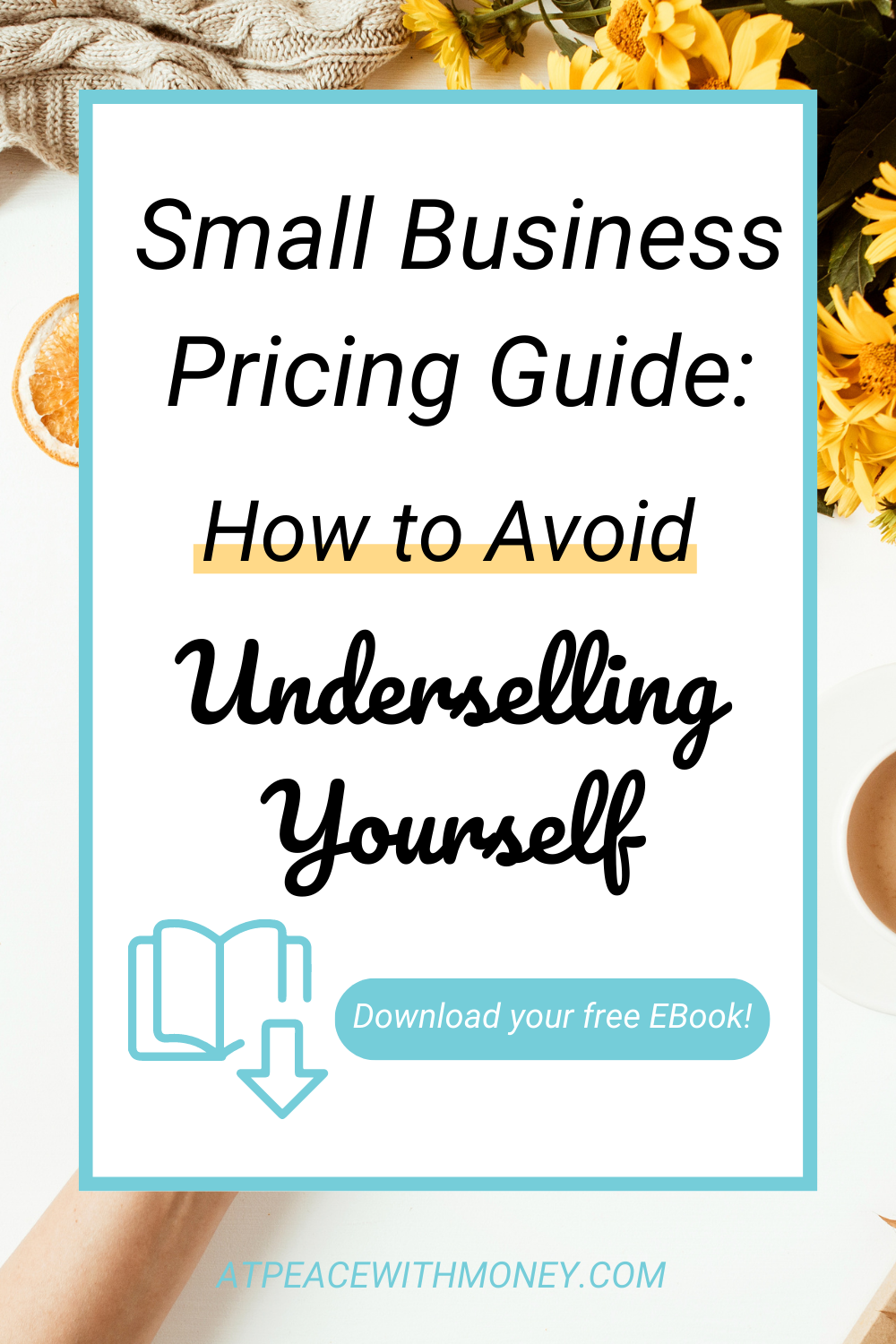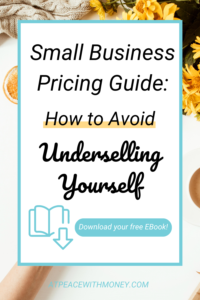Overcome Underearning: How to Avoid Underselling Yourself

A few years ago, I had the chance to speak with a group of businesswomen about their biggest financial mistakes. One that came up almost immediately was pricing products or services too low initially. Women especially struggle with worth and conceptualizing the value of their own labor, whether we’re working for an employer or ourselves.
Actually, I’d argue it can be even easier to get stuck in a cycle of chronically undervaluing yourself when you’re a solopreneur. One woman I spoke with shared about struggling with this. She priced her services too low initially. After realizing this, she found it difficult to raise her rates, because her first clients expected her low prices. She struggled between raising her prices and earning a wage that was too low for her needs.
Whether you’re in a similar position, or just starting out and not struggling with this, there are actions you can take to avoid this pitfall of solopreneurship.
Establish a Plan and a Purpose for Your Income
First, establish your money why – your purpose and plan for the money you earn though your business. Where will it go? What will it do? An important part of this process is looking through your expenses and determining how much your business will support you with them. Once you’ve established your money why, you’ll be able to set income goals based off this information, so that your income is truly able to cover your living expenses. Once you know how much money you need to make, it’s easy to figure out how high your prices need to be.
Consider Materials and Costs
Ask yourself a few more questions: What products or services are you planning to produce and sell most often? How much time, labor, and supplies will go into production? Account for those costs in your pricing formula, and make sure the answers are what you want them to be. If you’re planning to make most of your money from custom embroidered portraits, but you actually hate embroidery, maybe you’ll want to tinker with your profit model a bit. After this inquiry, you’re well on your way to pricing yourself well. For more resources, check out this article I wrote about my interview with Megan Auman.
Work on Your Mindset
If you’ve already priced your products and wound up in a similar situation to the woman above, you can still double back and figure out your true income targets and prices. The real challenge comes in actually implementing a rate change. Before you do this, it can be helpful to do some mindset work. Raising your rates can be a scary prospect that brings up all kinds of emotional baggage, but if you work on it, you can get to a point where you feel settled. Then, go ahead and raise your prices! You deserve to be comfortable and make a living wage. After all, isn’t that why you went into business for yourself?
If you enjoyed this post, you might also enjoy a free copy of my eBook, Reach Your Life Goals: a Business Owner’s Guide. Click here or below to download your free copy.












 Now that I’ve made a case for separating your business and personal finances, let’s go over two different ways you can do this. In the beginning of this article, I mentioned that some solopreneurs think its sensible to avoid opening another account. It’s true that this can help you bypass banking fees associated with business accounts.
Now that I’ve made a case for separating your business and personal finances, let’s go over two different ways you can do this. In the beginning of this article, I mentioned that some solopreneurs think its sensible to avoid opening another account. It’s true that this can help you bypass banking fees associated with business accounts.


 If you’ve already priced your products and wound up in a similar situation to the woman above, you can still double back and figure out your true income targets and prices. The real challenge comes in actually implementing a rate change. Before you do this, it can be helpful to
If you’ve already priced your products and wound up in a similar situation to the woman above, you can still double back and figure out your true income targets and prices. The real challenge comes in actually implementing a rate change. Before you do this, it can be helpful to 


 Another thing for product-based businesses to consider when looking at your pricing is your interest in wholesaling. When selling wholesale, you will typically sell at 50% of your retail price. If, at this price, you’re not covering your costs, labor and making a profit that supports your financial goals, you need to raise your prices.
Another thing for product-based businesses to consider when looking at your pricing is your interest in wholesaling. When selling wholesale, you will typically sell at 50% of your retail price. If, at this price, you’re not covering your costs, labor and making a profit that supports your financial goals, you need to raise your prices. 


 If you’ve spent much time in the business coaching sphere looking for advice, you may have come across someone’s ad inviting you to work with them to “Have your first 25k month!” (or whatever the promise is). While these nice round numbers might sound nice, they’re really there for the slogan, not for you.
If you’ve spent much time in the business coaching sphere looking for advice, you may have come across someone’s ad inviting you to work with them to “Have your first 25k month!” (or whatever the promise is). While these nice round numbers might sound nice, they’re really there for the slogan, not for you.



 Whether you decide to create a spending plan and reign in your expenses, or feel satisfied with your lifestyle costs, you now have a complete picture of your financial needs. At this point, you can now set informed income goals that are designed to meet those needs in your personal life. Without this crucial information, your goals will just be shots in the dark, aimed at an amount of money that “sounds nice” but doesn’t tangibly satisfy a need.
Whether you decide to create a spending plan and reign in your expenses, or feel satisfied with your lifestyle costs, you now have a complete picture of your financial needs. At this point, you can now set informed income goals that are designed to meet those needs in your personal life. Without this crucial information, your goals will just be shots in the dark, aimed at an amount of money that “sounds nice” but doesn’t tangibly satisfy a need.


 The bottom line here is that it’s important to look at both your personal and your business finances separately, and as they relate to each other. We have to look at the whole pie, so to speak. Many business owners might have one field or the other down pat, but having confidence in both areas takes a bigger understanding of how they work together. If you feel you have a lot of clarity in your business but struggle to pay personal bills, or vice versa, it’s time to take a step back and re-evaluate. The two inform each other.
The bottom line here is that it’s important to look at both your personal and your business finances separately, and as they relate to each other. We have to look at the whole pie, so to speak. Many business owners might have one field or the other down pat, but having confidence in both areas takes a bigger understanding of how they work together. If you feel you have a lot of clarity in your business but struggle to pay personal bills, or vice versa, it’s time to take a step back and re-evaluate. The two inform each other.


 If you’ve already priced your products and wound up in a similar situation to the woman above, you can still double back and figure out your true income targets and prices. The real challenge comes in actually implementing a rate change. Before you do this, it can be helpful to
If you’ve already priced your products and wound up in a similar situation to the woman above, you can still double back and figure out your true income targets and prices. The real challenge comes in actually implementing a rate change. Before you do this, it can be helpful to 


 Another thing for product-based businesses to consider when looking at your pricing is your interest in wholesaling. When selling wholesale, you will typically sell at 50% of your retail price. If, at this price, you’re not covering your costs, labor and making a profit that supports your financial goals, you need to raise your prices.
Another thing for product-based businesses to consider when looking at your pricing is your interest in wholesaling. When selling wholesale, you will typically sell at 50% of your retail price. If, at this price, you’re not covering your costs, labor and making a profit that supports your financial goals, you need to raise your prices.